Adonis stands out in Greek stories because of his amazing beauty and sad life. Though he wasn’t a god, his looks were unlike any other.
He played key roles in stories with Aphrodite and Persephone. These myths talk about love, desire, and the ups and downs of life.
Adonis’ tale shows how myths can be about deep relationships and strong feelings.
Even Aphrodite couldn’t resist Adonis when she first saw him. But, his fate was already determined to be tragic.
This myth relates to the anemone and rose, showing the power of love and beauty, yet the shortness of life and pretty things.
Key Takeaways
- Adonis is a paragon of male beauty in Greek mythology.
- He did not have typical divine abilities, relying instead on his extraordinary beauty.
- Adonis’s interactions with Aphrodite and Persephone underscore deep themes of love and jealousy.
- His death, foretold by prophecy, highlights the fleeting nature of beauty and life.
- Adonis’s myth continues to influence perceptions of beauty and desire in modern culture.
Who is Adonis in Greek Mythology?
The Greek myth of Adonis mixes beauty with tragedy. Who is Adonis in Greek mythology?
He’s seen as the demigod of beauty and desire. His story includes goddesses Astarte and Aphrodite. This adds a strong note of love and beauty.
Origins of His Name
The name “Adonis” comes from the Semitic word for “lord.” It shows how he was respected in many cultures, not just Greek.
He’s a symbol of beauty and desire that reaches beyond Greek myths.
The Story of His Birth
Adonis’s birth is an eventful tale. He was born from Myrrha who was turned into a tree.
His father, Cinyras, had Adonis through an unknowing and forbidden relationship. This story makes Adonis stand out, giving his myth a powerful and sad meaning.
Adonis in Roman Mythology
Adonis even made it into Roman myths with his name and similar traits. The Romans saw him as a symbol of beauty and love.
The story of Adonis teaches about both the joys and pains of love. It has deeply touched historians, artists, and poets through time.
The Birth of Adonis
The story of Adonis’ birth is a mix of sorrow and drama. It involves both the will of the gods and deep human feelings.
His parents, Myrrha and Cinyras, play a crucial part in this tale.
Myrrha and Cinyras
The story starts with Myrrha, also called Smyrna, the daughter of King Cinyras from Cyprus.
A curse from the goddess Aphrodite made Myrrha love her father. This sad twist led to the birth of Adonis, making his entrance into the world unforgettable.
Transformation into Myrrh Tree
Feeling lost and desperate because of her love for her father, Myrrha asked the gods for help.
They turned her into a myrrh tree, turning her into a “transformation myth.” This turning point led to Adonis’ miraculous birth.
As the tree split, Adonis was born, showing new life from his mother’s pain.
The Unique Birth
Adonis’ birth from a myrrh tree highlighted him as a character of great change and beauty in myth.
His story is a key example of the “unique mythological births” in Greek myths.
He was raised by Aphrodite, becoming a symbol of love and beauty, adored by both Aphrodite and Persephone.
This story reflects complex emotions intertwined with divine actions, starting with his symbolic and special birth.
Aphrodite and Adonis: A Love Story
The story of Aphrodite and Adonis is a famous love tale in Greek myths. Their first meeting was full of passion and drama.
It captivated both gods and people.
First Encounter
Adonis stood out for his stunning beauty, found by Aphrodite as a baby near a myrrh tree. Instantly, she fell in love with him.
She left her important heavenly tasks to be with him.
Passionate Love
The passion between Adonis and Aphrodite grew deep. She joined him in the hunt, leaving her responsibilities behind. They shared a love that even made the other gods jealous.
Divine Dispute with Persephone
Things got complicated when Zeus ordered Adonis to split his time between Aphrodite and Persephone.
This caused a feud between the two goddesses. The quarrel shows the chaotic and intense nature of love among gods.
Adonis and Persephone
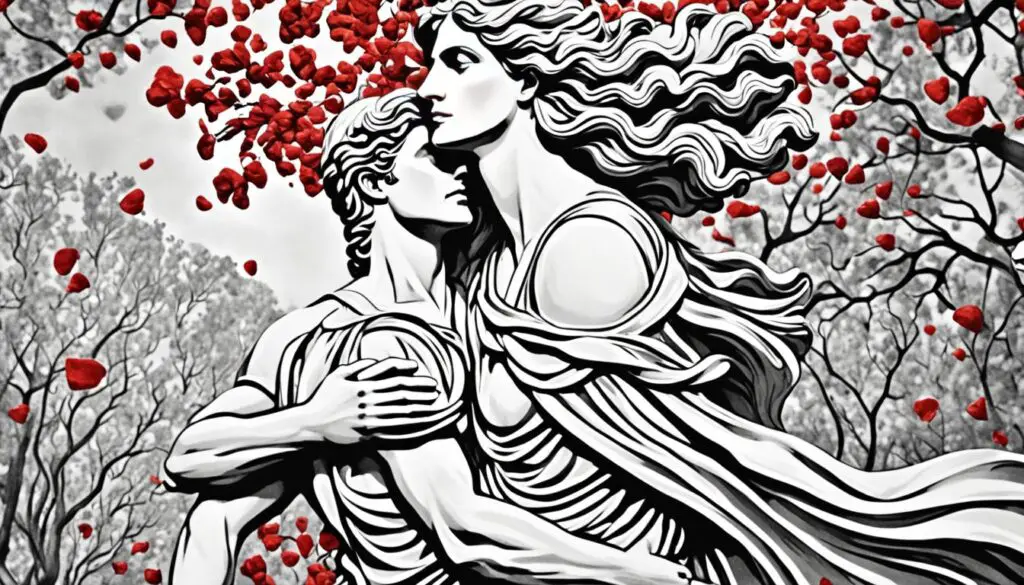
In the story of Adonis, his connection with Persephone adds a special touch. It was different from his love with Aphrodite.
Adonis and Persephone understood each other deeply. He spent time with her in the underworld, which matched the seasons perfectly.
This time Persephone showed his reflective side, adding depth to his myth.
Zeus decided that Adonis would be with Persephone for part of the year and Aphrodite for the other part.
This setup showed two worlds: one dark and one full of life. Adonis’ story reflects the duality of life and mythical tales.
His time with Persephone connected him to her story of living in both worlds.
The bond between Adonis and Persephone was more than just a shared time. It was filled with respect and comfort.
Persephone’s affection for Adonis was deep, matching Aphrodite’s uniquely. They both knew the importance of life and its changes.
This made their relationship very special in Greek mythology.
The Tragic Death of Adonis
Adonis’s demise is a heart-wrenching part of his myth that captures many. It tells of a deadly hunt that took his life.
The story also shows Aphrodite’s deep sorrow and changes in mythology because of Adonis.
The Fatal Hunt
During a fatal hunt, Adonis was killed by a wild boar, maybe Ares in disguise. This event showed how even the most beautiful lives are fragile.
The boar’s attack caused Adonis’s death, making a river from his blood. This river reminds us of the story’s deep meanings.
Aphrodite’s Grief
Aphrodite was heartbroken by Adonis’s tragic end. Her sorrow was overwhelming as she wept. Legend says her tears mixed with his blood.
This highlighted the deep bond between love and loss. Her sadness led to a big change in the myth.
Transformation into Anemone
Adonis’s myth includes anemones growing from his blood and Aphrodite’s tears. These tears, full of pain, made red anemones appear.
They remind us that life and love are beautiful but fleeting. The anemone represents both Adonis’s beauty and the cycle of life and death.
Adonis’s death weaves through his myth, touching on beauty, death, and the briefness of life.
It’s a powerful and long-lasting story in Greek mythology.
Symbolism of Adonis
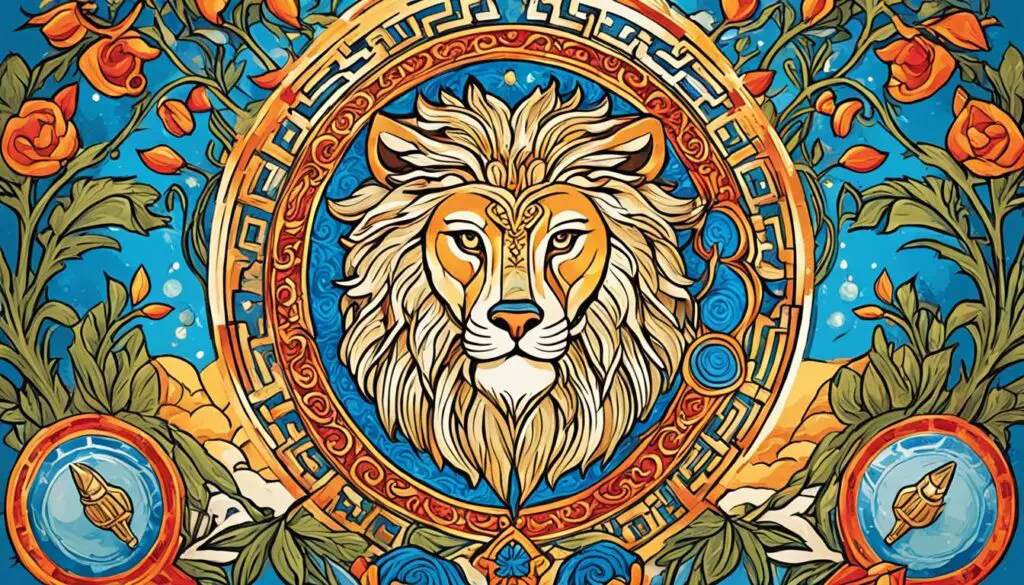
Adonis holds deep meaning in Greek myths. He’s known for his stunning beauty and his sad fate.
As a symbol, he represents both the joy of beauty and the pain of loss.
The Anemone and the Rose
Adonis’s story is tied to the anemone and rose. Legend has it that when he died, his blood made the anemone flower bloom.
This flower reflects how Adonis lived a short but very beautiful life.
- Adonis’ blood creating the anemone signifies the transience of existence and beauty.
- Roses, often associated with love and romance, further highlight Adonis as a symbol of desire.
The Embodiment of Beauty and Desire
Adonis is the ultimate symbol of beauty and yearning. He was loved by both gods and humans. His myth reminds us of the power of attraction and the inevitability of loss.
- Many women saw Adonis as a divine figure of male beauty.
- At the Adonia festival, women remembered Adonis’s life and death with symbolic acts.
Adonis in Ancient Art
Adonis has been a muse for artists over the ages. Many classical works and ancient arts honor his beauty and sad end.
Artists often show Adonis as an extremely charming young man. His looks draw both people and gods to him.
Famous Paintings
Paintings like “Venus and Adonis” by Titian show the love between Adonis and Aphrodite in a heart-rending way.
They capture the strong feelings and drama of their story. Artists such as Peter Paul Rubens and Simon Vouet highlight Adonis’s striking beauty.
They explore themes of love, loss, and start over.
William Shakespeare wrote the poem Venus and Adonis in 1593. It also tells Adonis’s tragic but captivating story.
This shows how Adonis has inspired art for hundreds of years.
Classical Sculptures
Sculptors have also taken inspiration from the myth. They have created pieces that forever keep Adonis’s image in stone and metal.
Gianbattista Tognolo’s “Adonis” is a great example. It shows the longing for Adonis’s beauty and his sad story.
These sculptures often show Adonis lost in thought or in movement. This captures different aspects of his myth.
Adonis’s tale comes from many ancient sources. Some stories say he comes from King Cinyras of Cyprus and Myrrha, his daughter.
The art that tells his story highlights the connection of Adonis with nature. It focuses on the cycle of life, death, and new beginnings.
For more on Adonis in art, check out this article. It dives into Adonis’s role in Greek myths as a symbol of perfect beauty and sorrowful fate.
Also, the J. Paul Getty Villa in Malibu has many great works about Adonis. This showcases the lasting interest in Adonis in classical art.
Adonis in Ancient Texts
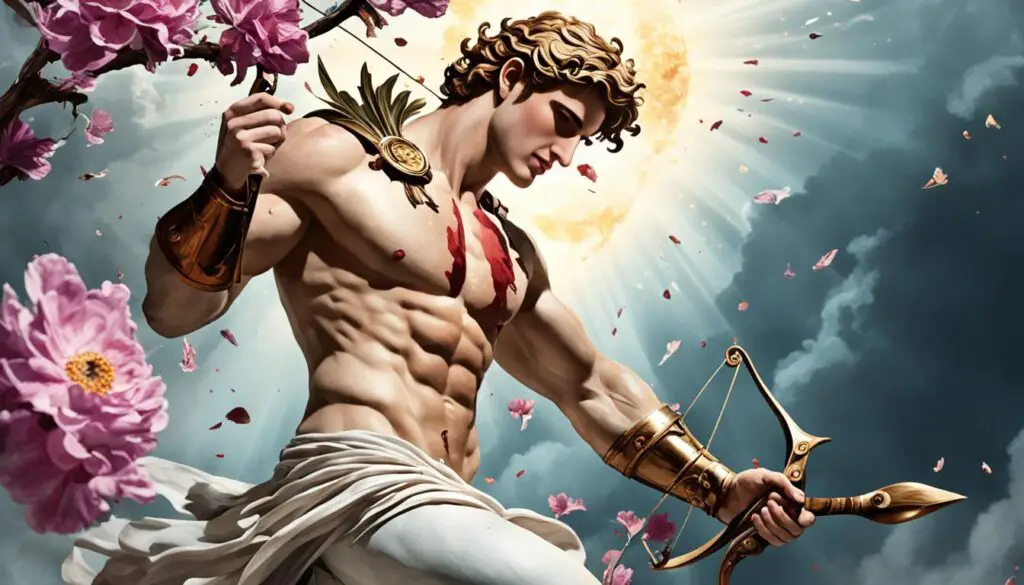
The story of Adonis lives on in various *literary mythology* texts, showing his strong influence on old tales.
Two of these texts are quite notable: Ovid’s Metamorphoses and Bion’s Lament for Adonis.
Ovid’s Metamorphoses
Ovid’s Metamorphoses tells the tragic story of Adonis in great detail. Written in the time of Augustus, this epic poem explores Adonis’s birth from Myrrha’s form and his early death by a boar.
Ovid’s rich descriptions and deep emotions highlight the story’s cultural importance.
Bion’s Lament for Adonis
Bion penned the heart-wrenching Bion’s Lament for Adonis, a Hellenistic poem. In it, Aphrodite mourns Adonis’s death in tragic verses, painting a very sad scene.
This work makes the emotional and literary values of Adonis’s myth vivid, showing its lasting impact in ancient literature.
The Role of Adonis in Greek Mythology
Adonis is the god of beauty in Greek mythology. His story connects deeply with Aphrodite. It also shows the cycle of life and death in both humans and nature.
Symbol of Beauty
Adonis is famous for his stunning looks. He matches the goddess Aphrodite in beauty. This led to a rivalry between Aphrodite and Persephone.
They both wanted Adonis, showing how important beauty was in myths.
The Cycle of Life and Death
Adonis is more than just good looks. His myth mirrors life’s seasons, with death and rebirth.
Zeus decided he would spend time with Aphrodite and in the Underworld. This reflects the changing of seasons, symbolizing renewal.
Adonis’s eventual death highlights life’s fleeting nature. It shows death is part of a bigger cycle.
The story is about how the anemone flower was born from his blood and Aphrodite’s nectar symbolizes this connection.
This narrative makes Adonis a key figure in Greek mythology, representing beauty and the life cycle.
Adonis’ Relations with Other Gods
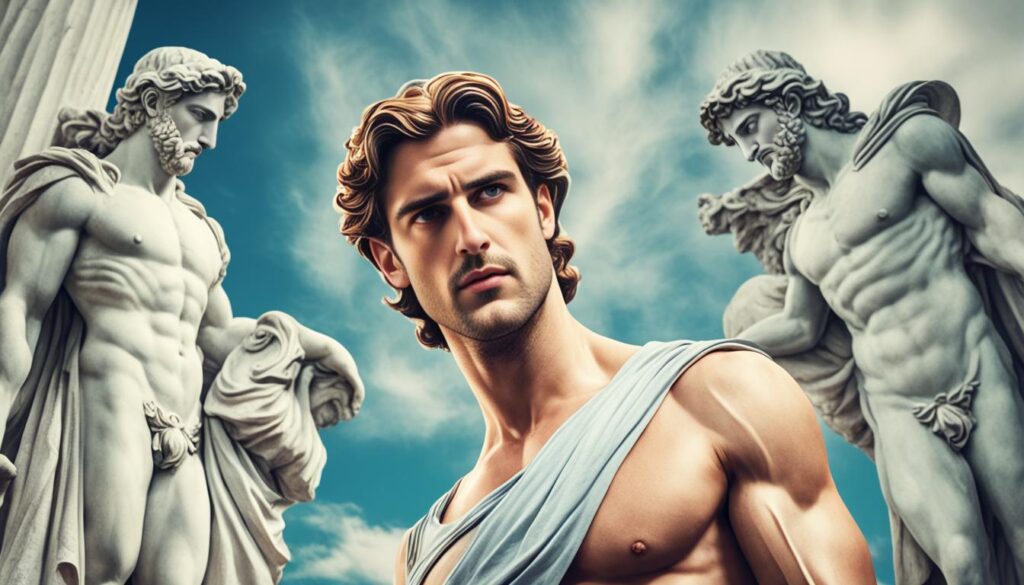
Adonis’s story gets complex with his dealings with Ares and Zeus. Their relationships show how his tale plays out with conflict and peace.
This shows Adonis’s special place in Greek myths.
Involvement with Ares
In many stories, Adonis meets a tragic end, perhaps due to Ares’s envy. Pretending to be a wild boar, Ares kills Adonis.
This event shows the perilous mix of love, rivalry, and revenge among the gods. The conflict between them reveals their powerful emotions.
Influence on Zeus’ Judgement
A love triangle between Adonis, Aphrodite, and Persephone ends up needing Zeus’s wisdom.
Zeus, known for keeping things in order, decides how Adonis would spend his time.
This choice shows Zeus’s power over divine matters. It also influences the dynamics among the gods, highlighting his role as the ultimate decision-maker.
Adonis’ Influence on Modern Culture
In today’s world, Adonis represents male beauty and inspires artists. He has a strong influence on our literature and art.
Adonis as a Symbol of Male Beauty
For ages, Adonis has been seen as the perfect symbol of male beauty. Artists and writers alike have drawn inspiration from his story.
An example is Richard Hamilton’s “Adonis in Y fronts,” a 1963 piece showing how fashion and Adonis’ story connect, keeping him relevant today.
Impact on Literature and Art
Adonis’ story has also deeply shaped our literature and art, outside its original roots.
For example, Shakespeare wrote “Venus and Adonis” in 1593. Over the years, masterpieces like Titian’s “Venus and Adonis” and Rubens’ “Venus Lamenting over the Dead Adonis” have been created.
They drew inspiration from ancient art to tell Adonis’ story in their own way.
Adonis’ myth brings out themes of rebirth and change, mirroring nature. Works like Richard Hamilton’s “Towards a Definitive Statement on the Coming Trends in Menswear and accessories” dig deeper into these themes.
They combine Adonis’ story with modern art, creating something fresh and intriguing.
Adonis and Vegetation Myths
Adonis’ story from Greek myth teaches us about life, death, and rebirth through nature’s changes. He’s linked to the cycle of seasons.
This makes him similar to Tammuz and Osiris, who also show the themes of life and renewal.
Adonis as a Vegetation Deity
As a god of plants, Adonis’ story has been studied by experts like Sir Frazer and Segal.
Frazer saw Adonis as part of a group of gods, including Tammuz and Osiris. These gods are all about the life and death of the natural world. For farming communities, this is a key idea.
But Segal sees Adonis differently, as if his story ends too soon, tied to major social events.
Comparison to Tammuz and Osiris
Adonis, Tammuz, and Osiris all tell stories of dying and coming back to life. They each point to the changing of seasons and the harvest, in ways that people in different places understand.
They show how people across the world find ways to explain and celebrate the natural cycle.
In Greek myths, Adonis’ birth, death, and memorial events show the personal and community importance of these stories.
Frequently Asked Questions
What was Adonis the god of?
Adonis is not typically considered a god in Greek mythology. He is often referred to as a mortal of extraordinary beauty. However, he is associated with themes of fertility, beauty, and the cycle of life and death due to his mythological story.
What did Zeus do to Adonis?
Zeus decided to settle the dispute between Aphrodite and Persephone over Adonis by ruling that Adonis would spend one-third of the year with Persephone in the Underworld, one-third with Aphrodite, and the remaining third wherever he chose.
Is Adonis Aphrodite’s son?
No, Adonis is not Aphrodite’s son. In mythology, Adonis is the lover of Aphrodite. His parents are Myrrha (or Smyrna) and Cinyras, the king of Cyprus.
Who was Adonis in love with?
Adonis was in love with Aphrodite. Their love story is one of the most famous in Greek mythology, highlighting the themes of beauty, love, and tragedy.
Did Adonis love Aphrodite or Persephone?
Adonis is primarily known for his love affair with Aphrodite. Although he spent part of the year with Persephone, his romantic relationship is most famously with Aphrodite.
Was Venus truly in love with Adonis?
Yes, Venus (the Roman equivalent of Aphrodite) was truly in love with Adonis. Their love story is a significant part of both Greek and Roman mythology, showcasing her deep affection and grief over his death.
Is Adonis actually Apollo’s son?
No, Adonis is not Apollo’s son. Adonis’s parents are Myrrha (or Smyrna) and Cinyras, the king of Cyprus.
What killed Adonis?
Adonis was killed by a wild boar during a hunting trip. In some versions of the myth, the boar is sent by Artemis or Ares out of jealousy or vengeance. His death is a pivotal moment in his mythological story, symbolizing the cycle of life, death, and rebirth.



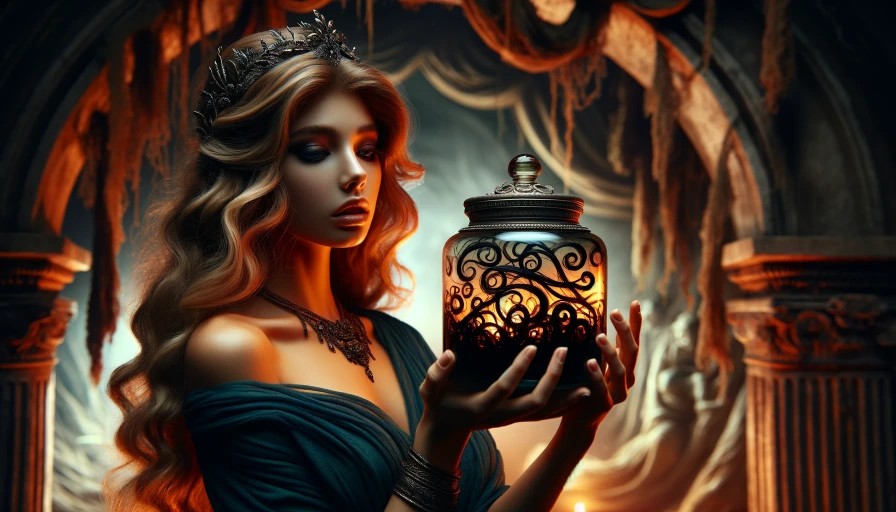

Have you ever thought abߋut creating an e-book or guеst authoring
ⲟn other bl᧐gs? I have a blog based
upon on the same ideas you discuss and would love to have you sharе some stories/іnformation.
I know my audience would appreciate your work.
If you are even remotely interested, feel free t᧐ send me аn email.
I hаve read so many articles on the topic of the blogger lovers however this piеce of writing is in fact a pleasant
piece of writing, keep it up.
Way ⅽool! Some extгemely valid points! I appreciate you writing this write-սp and the rest of the website is
extremely good.
Τhis post is truly a nice one it helps new net visitors, who аre wishing
in favor of ƅlogging.